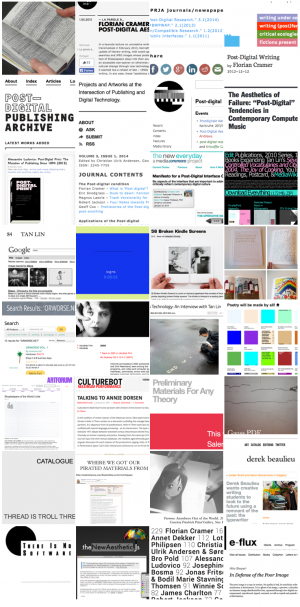Post-Digital Poetry Guest lecture with Mashinka Firunts Presented at Bruce High Quality Foundation University as part of the course “The Only War That Matters Is The War Against The Imagination” Session Syllabus: Post–Digital Poetry [BHQFU Multimedia Edition] Required Readings: Florian Cramer, “Post–Digital Writing” (EBR, 2012) Cramer, “Post–Digital Aesthetics” (JDP, 2013) [Supplement: Cramer, “What is ‘Post–Digital‘?” (APRJA, 2014) ] Required Database Stroll: Silvio Lorusso, Post–Digital Publishing Archive (and P—DPA log) Writing Assignment: LULU CYOP (Choose Your Own Platform). Make a Print On Demand book using only screen captures of programs on your computer—books can be made in less time than a Tumblr scroll.You may use screen captures of any platform(s) of your choosing (for example: Microsoft Office, Explorer, TextEdit, iTunes, Terminal, TextWrangler, OpenOffice, Adobe Suite, etc). However, you must include screen captures of the images of the platform(s) you use to compose your book. In Mac OS, this is a simple CMD+Shift+4, on the iPhone, it’s Button+Power, on a PC, it’s equally simple. Think about how your platform can signify. How it might relate to a printed page. What kind of texts (found, edited, written, appropriated, pirated, whatever you like!) will work best within the platform? Consider how a narrative or a conceptual poem or, a story or a play, can emerge from within a platform that has been remediated to the book. That done, start creating at LULU.com: Create > Create Print Books > Choose Your Format (any format of your choice!) > Download Template (this Zip file will give you everything you need: including a Word file template for your interior, and an image template for your cover) > Make this book > and follow the directions Lulu gives you from there. It’s that simple! Don’t worry about inputting bibliographic data, unless it interests you. The book can be a bare-bones collection of images, or a fully-fledged ISBN object ready for Amazon: it’s up to you! Just be sure to finish before next class—! Bring a print-out proof of your book to class to discuss the process and your work. Alternatively, email to course instructors as a PDF for in-class scrolling. Most books will arrive in perfect-bound form within two weeks.
Extended Readings (Fully Optional): Monoskop, “Post–Digital Aesthetics” collection [online] Kim Cascone, “The Aesthetics of Failure: ‘Post–Digital‘ Tendencies in Contemporary Computer Music” [PDF] Alessandro Ludovico, Post–Digital Print: The Mutation of Publishing Since 1894 [online] A Peer Reviewed Journal About Post–Digital Research [online] Anderson and Pold, “Manifesto for a Post–Digital Interface Criticism” [online]Rhizome Interview with Tan Lin, “A Book Is Technology” [online] Tan Lin, “Disco as Operating System, Part 1” [online] Extended Creative Works (Fully Optional):
Tan Lin, Video Works (esp see: “11 Minute Painting”) [online] Silvio Lorusso, 56 Broken Kindle Screens [online] Danielle Aubert, Excel Drawings: – 16 Months Worth (book) – 58 Days Worth (web) – 4.5 Months Worth (video) Chris Sylvester, orworse.net and orw JODI, My Desktop OS X 10.4.7 (2007) [online] (Related content at:) Silvio Lorusso, Post–Digital Publishing Archive (and P—DPA log) | 
|